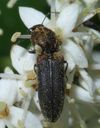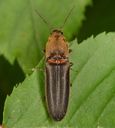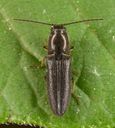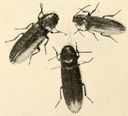Limonius
Limonius
Classification
- Phylum: Arthropoda
- Subphylum: Hexapoda
- Class: Insecta
- Order: Coleoptera
- Suborder: Polyphaga
- Superfamily: Elateroidea
- Family: Elateridae
- Subfamily: Dendrometrinae
- Tribe: Dendrometrini
- Subtribe: Dendrometrina
- Genus: Limonius
Pronunciation
How to pronounce Limonius: /lɪˈmoʊniəs/
These audio files are automatically generated. While they are not always 100% accurate, they are a good starting point.
Images






Summary
Limonius is a genus of click beetles known for their ecological role in decomposition and their characteristic ability to make a clicking sound when threatened. They are primarily found in Eurasia, with several species present in various habitats.
Physical Characteristics
Members of the genus Limonius are characterized by their elongated bodies, which are typical of click beetles, and possess the ability to produce a clicking sound due to their unique mechanism for jumping when threatened.
Identification Tips
Look for elongated, hardened bodies with a smooth or slightly textured exoskeleton. Species can often be identified by specific colors and markings, as well as the shape of their antennae and legs.
Habitat
Limonius species are typically found in various habitats, including woodlands, grasslands, and sometimes in gardens or agricultural lands.
Distribution
Widespread across Eurasia, with approximately 30 species identified in our region.
Diet
Most Limonius species are herbivorous, feeding on decaying plant material, roots, and sometimes fungi.
Life Cycle
Limonius undergo complete metamorphosis, transitioning from egg to larva to pupa before emerging as an adult.
Reproduction
Reproduction commonly occurs in warmer months, and females lay eggs in soil or under decayed vegetation where larvae will have food resources upon hatching.
Predators
Predators include birds, mammals, and other predatory insects that feed on beetles.
Ecosystem Role
Limonius species play a crucial role in decomposing organic matter, thus contributing to soil health and serving as food sources for other wildlife.
Economic Impact
Some Limonius species may have limited impact on crops, but they are generally not considered significant pests.
Collecting Methods
- Light trapping at night
- Hand collecting from under debris or on vegetation
Preservation Methods
- Pinning
- Drying
- Storing in ethanol
Evolution
The genus Limonius is part of a larger evolutionary radiation that illustrates the diversity within the family Elateridae and the adaptability of click beetles.
Similar Taxa
- Gambrinus
- Dendrometrus
Misconceptions
There are few misconceptions surrounding Limonius, but some may confuse them with other beetles due to similar body shapes.
Tags
- Insect
- Beetle
- Coleoptera
- Elateridae
- Limonius